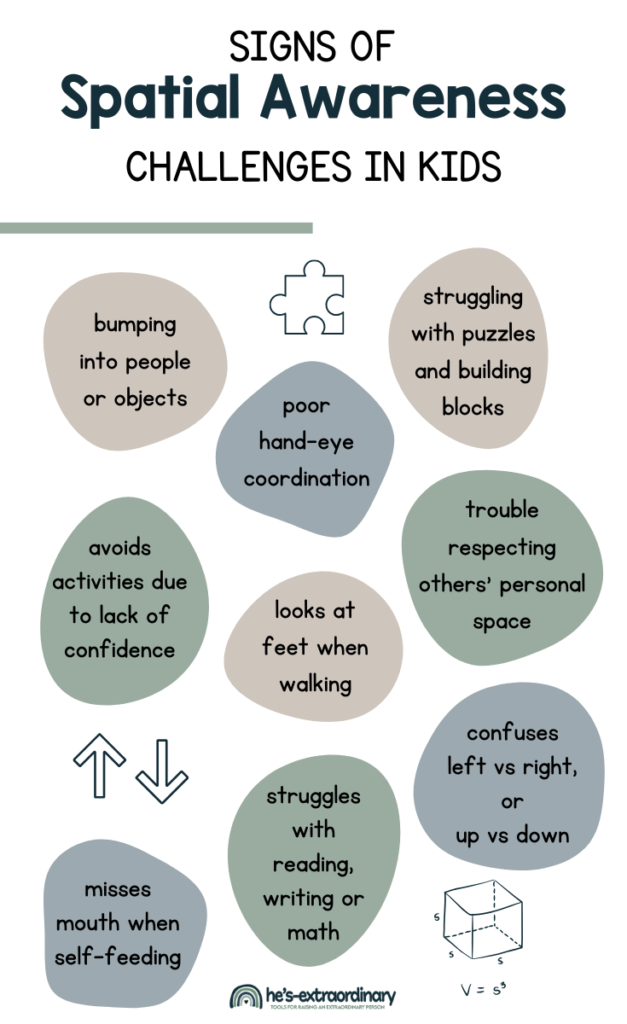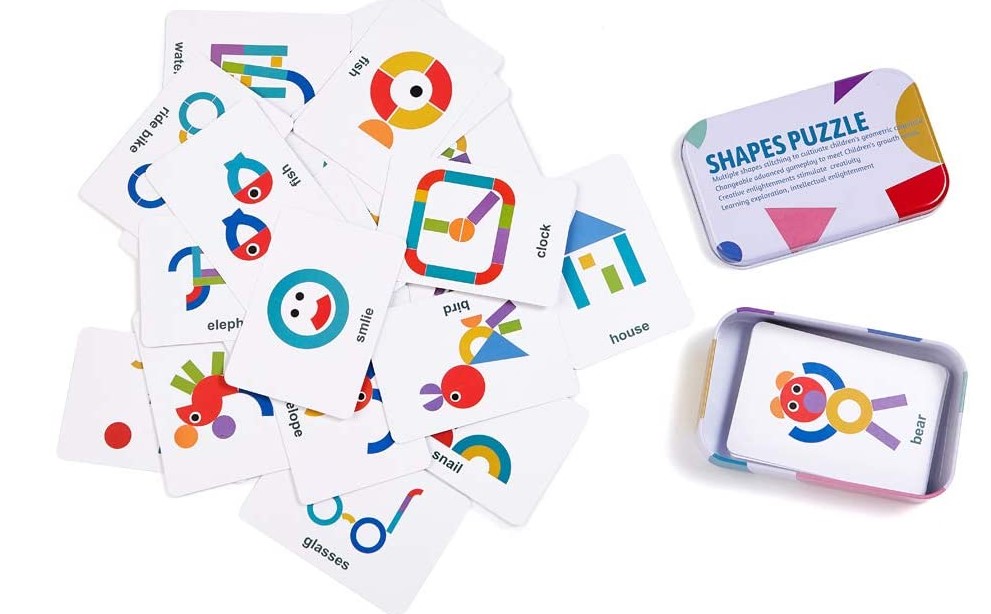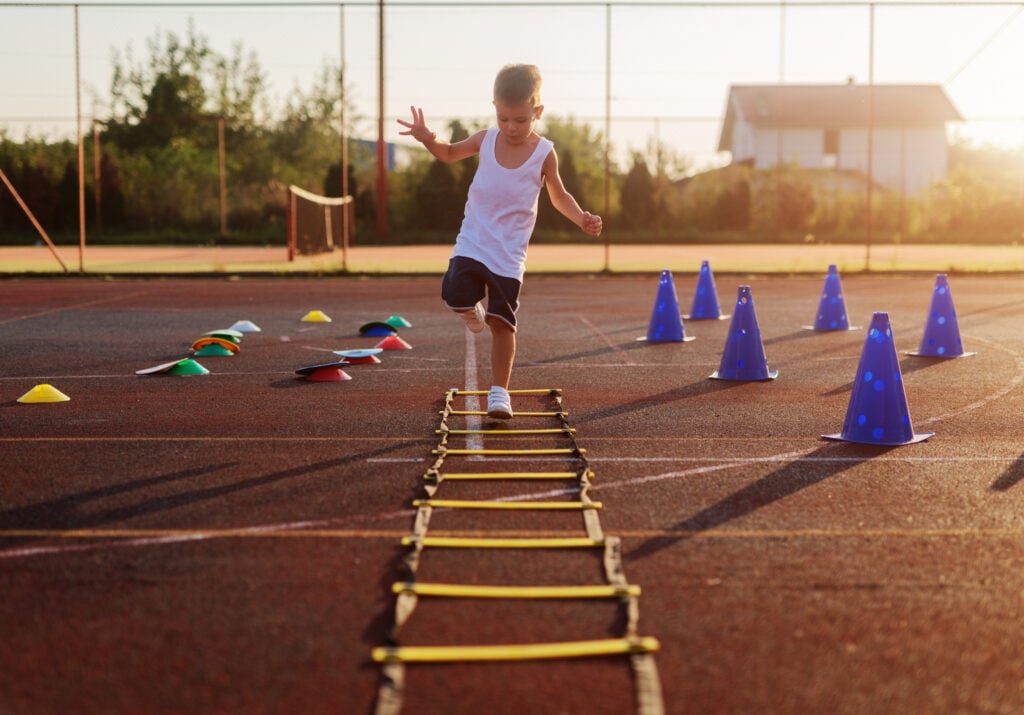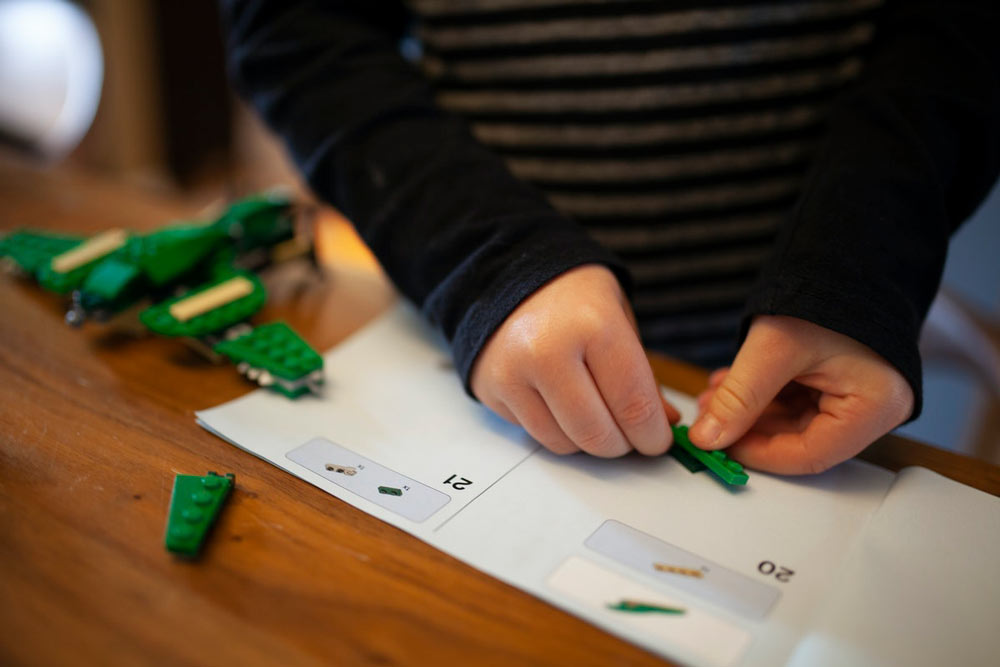Spatial Awareness Activities for Kids: 45+ Fun Games & Exercises
What’s inside this article: A look at what spatial awareness is and why it’s important. Signs of spatial awareness problems in kids and what may cause those problems. Games and play-based activities to help children of all ages practice and develop spatial awareness.
Disclaimer: This post contains affiliate links.
Maybe they’re constantly tripping, misjudging distances, or having a hard time navigating crowded spaces without collisions? I get it – and you’re not alone in wondering what’s going on.
These everyday challenges usually come down to something called spatial awareness.
And here’s what many parents don’t realize: when kids struggle with spatial awareness, it doesn’t just affect their safety – it can also impact their success in math, reading, and other academic areas.
The good news? This is totally something you can help your child work on through fun, play-based activities!
What Is Spatial Awareness?
Spatial awareness is the understanding and perception of the space around oneself and the objects within that space.
It means knowing where your body is in relation to other objects and people and being able to navigate and move through space efficiently.
This skill relies heavily on your body’s internal GPS system – particularly your proprioceptive system, which tells your brain where your body parts are positioned without you having to look at them. When proprioception and spatial awareness work together, you can reach for a glass of water without knocking it over or navigate a crowded hallway without bumping into people.
This skill is crucial for everyday tasks, from walking around without bumping into things to arranging items in a drawer or playing sports.
Kids are constantly using spatial awareness. For example, at the playground, they use spatial awareness to judge distances between objects, decide where to place their feet to climb a ladder, determine if they can fit through spaces between bars, and assess how far they can jump from one piece of equipment to another.
They must also be aware of other children playing around them to avoid collisions, requiring them to adjust their movements and path based on the changing positions of others.
Spatial awareness is a fundamental aspect of human cognition, enabling individuals to interact with their environment effectively and safely.
Spatial Awareness and Sensory Processing
The sensory systems most closely related to spatial awareness include:
- Proprioceptive System: Proprioception involves sensors in the muscles, tendons, and joints that provide feedback to the brain about body position and movement. This sensory system lets you know the position of your body parts without having to look at them, enabling coordinated movement.
- Vestibular System: Located in the inner ear, the vestibular system plays a key role in balance and spatial orientation. It detects changes in head position and movement, helping to maintain balance and providing information about your position in relation to gravity. This system is essential for maintaining posture and coordinating head and eye movements.
- Visual System: Vision provides critical information about your environment, including the location of objects, their movement, and spatial relationships between objects. The visual system helps you determine depth, distance, and perspective, which are essential for spatial awareness.
These three sensory systems work together to provide a comprehensive understanding of your body in space and the spatial relationships with objects and people in the environment.
Efficient integration of information from these senses is vital for developing and maintaining good spatial awareness, which is foundational for motor skills and performing complex tasks in daily life.
Why is Spatial Awareness Important?
Spatial awareness is a critical cognitive skill that impacts numerous aspects of daily life and overall development.
- Safety: Spatial awareness helps kids navigate their environment safely, allowing them to avoid obstacles, gauge distances accurately, and prevent accidents. For example, being aware of the space around them helps kids avoid running into one another in the hallway.
- Motor Skills Development: For children, especially, spatial awareness is crucial for developing both gross and fine motor skills. It enables them to coordinate their movements in relation to their surroundings, which is essential for activities ranging from reaching and grasping objects to running, jumping, and playing sports.
- Learning and Academic Success: Spatial awareness is closely linked to success in several academic areas, including math, science, and art. It also supports reading and writing skills, as kids must understand the spatial orientation of letters and words on a page.
- Social Interactions: Spatial awareness contributes to understanding personal space, which is important for social interactions. Recognizing and respecting the physical space around themselves and others can improve communication and social relationships.
- Independence and Confidence: Good spatial awareness can increase a child’s level of independence and confidence in their ability to perform tasks and engage in various activities. It allows for more effective and autonomous navigation of the world.
- Enhanced Physical Activity: Spatial awareness is essential for participation in sports and other physical activities. It allows kids to understand strategy and positioning in team sports.
Signs of Spatial Awareness Challenges in Kids
Spatial awareness develops throughout childhood. Remember when your child was just a baby, reaching out and trying to grasp objects for the first time and missing them? That’s just the very beginning when this skill starts emerging.
Recognizing signs of spatial awareness challenges in children is important for early intervention and support.
Here are some common signs that a child may be experiencing difficulties with spatial awareness:
- Bumping into objects or people frequently
- Difficulty with sports or physical activities, for example, struggling to coordinate movements with other players, objects, or boundaries in sports.
- Challenges with puzzles and building blocks, such as not understanding how pieces fit together or difficulty constructing with blocks.
- Problems with handwriting and drawing
- Difficulty following directions involving spatial concepts: For example, “Your shoes are beside the door” or “The towels are under the sink.”
- Poor sense of direction.
- Trouble with sequencing and organization tasks. For example, difficulty following multi-step instructions or logically organizing personal belongings.
- Avoidance of certain activities or sports due to lack of confidence.
- Difficulty with tasks requiring eye-hand coordination
- Trouble respecting personal space
- Difficulty in school with reading, writing, or math
- Looks down at their feet while walking because they stumble otherwise
- Misses mouth when self-feeding
- Problems understanding directions like left vs. right and up vs. down
- Writes vertically instead of horizontally or starts sentences in the middle of the page.

What Causes Challenges with Spatial Awareness?
Multiple areas of the brain play a role in spatial awareness, and typically, this skill starts developing in infancy.
However, there are several reasons a child may have trouble developing spatial awareness, such as:
- Sensory processing disorder, which occurs when sensory signals are not organized and processed into appropriate behavioral responses.
- Autism
- Dyspraxia, a brain-based motor disorder
- Cerebral Palsy, which is a group of disorders affecting movement and coordination
- Turner Syndrome, which is a chromosomal abnormality
- Non-Verbal Learning Disorder (NVLD), kids with NVLD are not nonverbal, as the name suggests, and have no difficulty reading. It’s a visual-spatial learning disability. They have difficulty processing visual-spatial sensory information, which can cause problems with math, executive function, and fine motor and social skills.
Improving Spatial Awareness
You can improve spatial awareness skills with practice. Regularly discussing locations and distances helps reinforce those concepts. As well as play-based activities that help children practice and use their spatial awareness skills.
Certain hobbies promote spatial awareness, like drawing and building with Lego. Even playing video games, like Minecraft, where you must manipulate objects and build, or puzzle games, like Tetris, help develop spatial awareness.
For children with significant challenges, professional support from an occupational therapist can be invaluable. These specialists can provide tailored activities and exercises to develop spatial awareness based on the child’s specific needs.
45+ Strategies and Activities for Building Spatial Awareness
Various strategies and activities can help develop this important skill:
Use Spatial Language
You can turn everyday moments into spatial awareness practice by naturally weaving spatial words into your conversations.
Instead of just saying “Get your shoes,” try “Your shoes are beside the door” or “Can you put your backpack under the coat hook?”
Spatial terms you can use in conversation include: “over,” “under,” “near,” “far,” “left,” and “right.”
Make it playful by giving silly directions like “Can you hop over the invisible line?” or “Let’s see if you can crawl under this imaginary bridge!” During car rides, point out landmarks: “Look, the gas station is to the right of the grocery store” or “We’re driving behind the blue car.”
The key is making spatial language feel natural and fun rather than like a lesson. Kids absorb these concepts best when they’re woven into real-life situations they actually care about.
Puzzles
Solving puzzles requires recognizing shapes and how they fit together, which can enhance spatial reasoning skills.
Choose puzzles that suit your child’s age and abilities, without being too challenging or too easy.
There are many different kinds of puzzles, including shape sorters, jigsaw puzzles, peg puzzles, and 3D puzzles.
These shape puzzles are a great choice. They come with a deck of 50 cards and wooden shapes that children can put together, creating the image on the card.
There are so many things kids can make, it allows them to practice again and again using the same set up materials.

For older kids, another great puzzle activity is Mental Blox. It’s similar to the puzzles above, but more challenging, because you must use three-dimensional shapes to recreate the images.
Find The Block
This is such an easy game to play – it doesn’t have to be a block; it could be a favorite toy or plushie, but we always use a block.
Hide the object somewhere within the room and use directional instructions to tell your child where it is and have them find it.
For example, “The block is on the bottom shelf of the bookshelf, to the left of the TV stand”
Build an Obstacle Course
The ability to maneuver through an obstacle course requires spatial awareness.
Should you climb over that or crawl under it?
You can create obstacle courses in your home using chairs, couch cushions, tables, etc.
Or, turn the playground or your backyard into an obstacle course.
Play a game of follow the leader and show your child how to maneuver through the playground equipment, providing help if needed.

Block Play
Block play is super important in early childhood, Children should have the opportunity to play and build with a variety of blocks, from small lego to large interlocking blocks, wooden blocks, and even large foam blocks.
As children arrange (and rearrange) blocks, they become more aware of the space and positioning of objects. You can also use block play as an opportunity to practice verbal instructions, for example “Place two blue blocks on top of one red block“.
Teach Personal Space
If a child has poor spatial awareness, they may invade the personal space of others because they simply aren’t aware that their body is too close to another person’s.
When that’s the case, you may need to explicitly teach the concept of personal space, offering concrete ways to help them understand socially acceptable proximities based on the relationship they have with different people.
There are a lot of great children’s books that teach this concept and several activities you can use – read how to teach children to respect personal space here.
Sports and Physical Activity
Basketball, baseball, soccer – any game involving a ball helps develop spatial awareness. Learning how hard to kick the soccer ball so it reaches the net, how to dribble the basketball, how to swing a baseball bat just in time to hit the ball thrown by the pitcher – these athletic skills all require spatial awareness.
Gymnastics and dance – Both require and help build a strong sense of body awareness and a better understanding of proximity to others and to the objects around you.
Non-organized physical activity – Your child doesn’t need to join an organized sport; there are benefits to all physical activity. Whether it’s biking, swimming, or just running around the yard.
Check out this animal-themed workout for kids and give it a try.
Interactive Games
Interactive games require children to process verbal instructions and turn them into spatial movements.
Play games such as:
- Simon Says
- Red Light, Green Light
- Mother May I?
- Charades
- Hopscotch
- Hide and Seek
- Red Rover

Sensory Play
Activities that involve sensory input help children explore and learn about space and volume in a hands-on way. These activities are particularly effective because they engage multiple sensory systems that work together to build spatial awareness.
Sandbox and water play naturally teach concepts like volume, depth, and spatial relationships as kids pour, dig, and build. But you can also incorporate activities that specifically target the sensory systems most connected to spatial awareness:
Proprioceptive Activities (body awareness through muscles and joints):
- Wall push-ups and floor push-ups
- Animal walks like bear crawls and crab walks
- Jumping activities – trampolines, jumping jacks, or hopping games
Heavy Work Activities (deep pressure input that helps with body awareness):
- Carrying books or laundry baskets
- Pushing chairs or heavy objects
- Pulling wagons or sleds
Vestibular Activities (balance and movement):
- Swinging, spinning, or rocking activities
- Balance beam walking or yoga poses
- Rolling down hills or doing somersaults
These types of sensory activities give kids important information about where their body is in space, which directly supports spatial awareness development.
For comprehensive lists of activities that target these systems, check out:
Yoga and Movement Exercises
Yoga poses and movement exercises require children to be aware of their bodies in space, improving both proprioception and spatial awareness.
Check out some of these activities:
- 7-Minute HIIT Workout for Kids
- Free Printable: Yoga Pose Flash Cards
- Free Printable: Animal-Themed Gross Motor Game
- Cosmic Kids Yoga on YouTube

Video Games and Educational Apps
Video games and educational apps can be effective tools for enhancing spatial awareness in a fun and engaging way.
Here’s a list of some games and apps that are known to help build spatial awareness skills:
- Minecraft: Allows players to build and explore virtual worlds, enhancing spatial reasoning as they navigate and manipulate 3D environments.
- Tetris: A classic puzzle game that requires players to rotate and arrange falling blocks to complete lines, improving spatial recognition and planning skills.
- Portal and Portal 2: These puzzle-platform games challenge players to solve spatial puzzles using a portal gun to create pathways through the game environment, enhancing problem-solving and spatial reasoning.
- The Room series: A set of puzzle games that involve unlocking and exploring intricate 3D puzzle boxes, requiring spatial thinking and attention to detail.
- Lightbot: A programming puzzle game that introduces coding concepts through solving spatial puzzles, teaching problem-solving, and planning in a spatial context.
- DragonBox Elements: A geometry game that helps players understand geometric shapes and their properties by solving puzzles based on Euclidean geometry.
- Monument Valley and Monument Valley 2: Puzzle games that involve manipulating impossible architecture and guiding a character through mazes of optical illusions, enhancing spatial perception and problem-solving skills.
- Bloxels: An educational platform that lets children design their own video games, including creating characters, environments, and levels, fostering creativity and spatial awareness.
- Brain Builder: An app that offers a series of games designed to improve spatial intelligence, including puzzles that require manipulating shapes and objects in space.
- Spatial Visual Intelligence Puzzle: An app that features puzzles requiring the arrangement of blocks and shapes to fit into a specified space, improving spatial visualization skills.
Drawing and Art Projects
Activities that involve drawing, coloring, and crafting can help children understand spatial concepts like size, shape, and position as they create and interpret visual representations.
- 3D Model Building: Using materials like clay, playdough, or building blocks to create three-dimensional models.
- Perspective Drawing: Learning to draw scenes or objects from different perspectives (e.g., one-point, two-point perspective) helps with understanding spatial relationships and depth perception.
- Map Making: Creating maps of familiar places, like their home, neighborhood, or a fictional place. This activity encourages spatial reasoning by requiring the translation of a three-dimensional space into a two-dimensional representation.
- Geometric Shape Collages: Cutting out and arranging various geometric shapes to create a collage. This project helps with recognizing and understanding the spatial properties of different shapes and how they relate to each other.
- Symmetry Drawing: Drawing the mirror image of a given shape or picture on the opposite side of a line of symmetry.
These activities encourage the development of spatial awareness by engaging individuals in tasks that require them to perceive, manipulate, and interact with space and forms in creative ways.
When to Seek Professional Help with Spatial Awareness
While many spatial awareness challenges can be supported and improved over time through practice and play, there are times when professional guidance from an occupational therapist may be needed.
Consider reaching out for an evaluation if your child:
- Shows multiple signs of spatial awareness challenges that don’t improve with practice
- Frequently gets hurt due to spatial misjudgments (bumping into things, falling, misjudging distances)
- Avoids physical activities, sports, or playground equipment due to spatial difficulties
- Struggles significantly with academic tasks like math, reading, or writing despite other support
- Has difficulty with daily self-care tasks like getting dressed, eating, or personal hygiene
- Shows signs of low confidence or frustration related to physical activities or movement
- Has been diagnosed with conditions that commonly affect spatial processing (autism, ADHD, sensory processing differences)
An occupational therapist can assess your child’s specific needs and create a tailored plan that builds on their strengths while addressing challenges.
They can also help determine if other factors might be contributing to spatial difficulties.
Remember, seeking help isn’t about “fixing” your child – it’s about giving them the tools and support they need to feel confident navigating their world.
Spatial awareness is an important skill that impacts daily activities, social skills, motor skills, and academics.
By recognizing early signs of spatial challenges and engaging in targeted activities, like the ones mentioned above, parents and educators can help children improve their spatial awareness.
For children with significant challenges, parents should seek professional support from an occupational therapist, who can provide individualized activities and exercises to improve spatial awareness.


